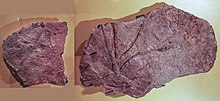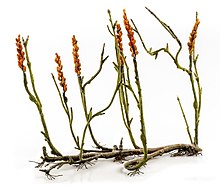Zosterophyll
| Zosterophyll Temporal range:
| |
|---|---|

| |
| Zosterophyllum species fossils; left: with coiled (circinate) branch tips, right: with sporangium | |

| |
| Zosterophyllum Life restoration from MUSE | |
| Scientific classification | |
| Kingdom: | Plantae |
| Clade: | Tracheophytes |
| Clade: | Lycophytes |
| Plesion: | †Zosterophylls |
| Order | |
| |
The zosterophylls are a group of extinct
Morphology

The stems of zosterophylls were either smooth or covered with small spines known as
The zosterophylls were named after the aquatic flowering plant Zostera from a mistaken belief that the two groups were related. David P. Penhallow's generic description of the type genus Zosterophyllum refers to "Aquatic plants with creeping stems, from which arise narrow dichotomous branches and narrow linear leaves of the aspect of Zostera."[4] Zosterophyllum rhenanum was reconstructed as aquatic, the lack of stomata on the lower axes giving support to this interpretation.[3] However, current opinion is that the Zosterophylls were terrestrial plants, and Penhallow's "linear leaves" are interpreted as the aerial stems of the plant that had become flattened during fossilization.[5]
Stomata were present, particularly on the upper axes. Their absence on the lower portions of the axes suggests that this part of the plants may have been submerged, and that the plants dwelt in boggy ground or even shallow water.[3] In many fossils these appear to consist of a slit-like opening in the middle of a single elongated guard cell, leading to comparison with the stomata of some mosses.[6] However, this is now thought to result from the loss of the wall separating paired guard cells during fossilisation.[7][8]
Taxonomy and classification
At first most of the fossilized early land plants other than
Bank's classification produces the hierarchy:- Division Tracheata
- Subdivision †Zosterophyllophytina = zosterophyllophytes, zosterophylls
- Subdivision Lycophytina = lycopods
- + other subdivisions
Those who treat most of the extant groups of plants as divisions may raise both the zosterophylls and the Lycophytina sensu Banks to the rank of division:[13]
- Division Zosterophyllophyta = zosterophylls, zosterophyllophytes
- Division Lycophyta = lycophytes
In their cladistic study published in 1997,[14] Kenrick and Crane provided support for a clade uniting both the zosterophylls and the lycopsids, producing a classification which places the zosterophylls in a class Zosterophyllopsida of the subdivision Lycophytina:[15]
- Division Tracheata
- Subdivision Lycophytina = lycophytes
- Class †Zosterophyllopsida = zosterophylls
- Class Lycopodiopsida = lycopsids
This approach has been widely used alongside previous systems. A consequence is that "lycophyte" and corresponding formal names such as "Lycophyta" and "Lycophytina" are used by different authors in at least two senses: either excluding zosterophylls in the sense of Banks or including them in the sense of Kenrick and Crane.
A further complication is that the cladograms of Kenrick and Crane show that the zosterophylls, broadly defined, are paraphyletic, but contain a 'core' clade of plants with marked bilateral symmetry and circinate tips. The class Zosterophyllopsida sensu Kenrick & Crane may be restricted to this core clade,
Under whatever name and rank, the zosterophylls have been divided into orders and families, e.g. the Zosterophyllales containing the Zosterophyllaceae and the Sawdoniales containing the Sawdoniaceae.[citation needed] Since the publication of cladograms showing that the group is paraphyletic[14][17] divisions of the class have been less used, being ignored, for example, in the 2009 paleobotany textbook by Taylor et al.[13]
Phylogeny
In 2004, Crane et al. published a unified
|
zosterophylls in the broadest sense |
Genera
Genera which are included at or around the zosterophyll position in the cladogram or have otherwise been included in the group by at least one source, and hence may be considered zosterophylls in the broadest sense, are listed below.[1][14][9][18][19] "B" indicates genera included by Banks in his 1975 description of Zosterophyllophytina.[10]
- Adoketophyton
- Anisophyton
- Barinophyton
- Bathurstia (B)
- Crenaticaulis (B)
- Danziella
- Deheubarthia
- Demersatheca
- Discalis
- Distichophytum (B)
- Gosferia (= Forgesia)
- Gosslingia (B)
- Guangnania
- Gumuia
- Hicklingia
- Hsua
- Huia
- Jugumella
- Konioria
- Macivera
- Nothia
- Oricilla
- Protobarinophyton
- Ramoferis
- Rebuchia, see Distichophytum
- Sawdonia (B)
- Serrulacaulis
- Tarella
- Thrinkophyton
- Trichopherophyton
- Ventarura
- Wenshania
- Xitunia
- Yunia
- Zosterophyllum (B)
Genera may not be assigned to this group by other authors; for example, Adoketophyton was regarded by Hao et al., who named the genus, as having evolved separately from the lycopsids, so that its taxonomic placement was uncertain.[20] Barinophytes, like Barinophyton, have been considered to be possible lycopsids,[21] or to fall between the lycopsids and the euphyllophytes.[19]
See also
- Drepanophycales, a clade of early lycopods
References
- ^ JSTOR 2399750
- PMID 21665700
- ^ ISBN 978-0-521-38294-6
- ^ Penhallow, D.P. (1892), "Additional notes on Devonian plants from Scotland", Canadian Record of Science, 5: 1–13
- ISBN 978-0-12-199920-9
- ISBN 978-1-85996-130-8
- ^ PMID 21652317
- ^ a b Banks, H.P. (1968), "The early history of land plants", in Drake, E.T. (ed.), Evolution and Environment: A Symposium Presented on the Occasion of the 100th Anniversary of the Foundation of Peabody Museum of Natural History at Yale University, New Haven, Conn.: Yale University Press, pp. 73–107, cited in Banks 1980
- JSTOR 1219491
- ^ ISBN 978-0-12-373972-8, p. 1028
- ^ ISBN 978-1-56098-730-7
- ISBN 978-0-231-11161-4
- S2CID 3866183
- ^ ISBN 978-7-03-036616-0, retrieved 2019-10-25
- ISBN 978-0-12-373972-8.
